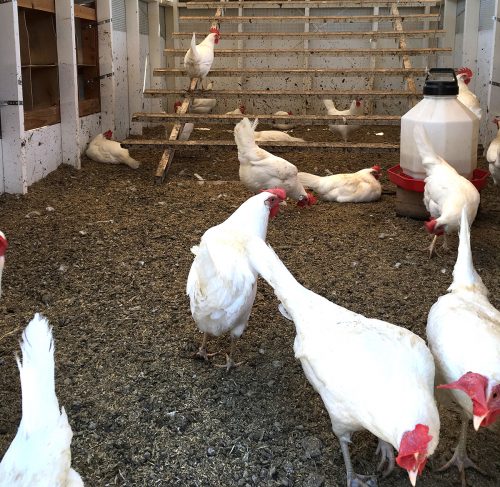Vulnerabilities in America’s Agricultural Sector
Bennie I. Osburn – March 2, 2018
 The increasing rate of emerging and reemerging zoonotic disease, along with threats and attempts by those with nefarious intent to attack food and agriculture, point to the need to exert more effort to eliminate vulnerabilities and reduce consequences associated with America’s agricultural sector – Executive Summary, Defense of Animal Agriculture, Bipartisan Report of the Blue Ribbon Study Panel on Biodefense, October 2017
The increasing rate of emerging and reemerging zoonotic disease, along with threats and attempts by those with nefarious intent to attack food and agriculture, point to the need to exert more effort to eliminate vulnerabilities and reduce consequences associated with America’s agricultural sector – Executive Summary, Defense of Animal Agriculture, Bipartisan Report of the Blue Ribbon Study Panel on Biodefense, October 2017
A good example of our nation’s vulnerability was the highly pathogenic strain of avian influenza that entered the United States via migrating wild birds in 2014 and resulted in the biggest animal health disaster ever experienced in the country. State and federal governments spent $879 million on outbreak response. The outbreak impacted 21 states and led to the depopulation of more than 50 million birds on 232 farms.
WIFSS has multiple projects and resources to train members of the agriculture community about the dangers of Agroterrorism and natural disasters. It received a Specialty Crop Grant from the California Department of Food & Agriculture to assist companies in developing food defense plans as mandated by the Food Safety Modernization Act. WIFSS currently offers an awareness level course, All Hazards Preparedness for Animals in Disasters; and a management course, All Hazards Planning for Animal, Agricultural, and Food Related Disasters. We will soon be revising our Department of Homeland Security AWR-152 Principles of Preparedness for Agroterrorism and Food Systems’ Disasters course.
In serving the global community, WIFSS conducts research, develops training, and provides outreach programs that will enhance the health and security of people, animals, and the environment. We partner with multiple academic institutions and government agencies.
Taking Action
Concerned about intentional tampering of the food supply, the Federal Bureau of Investigation (FBI) and the U.S. Department of Agriculture, Animal Plant Health Inspection Service (USDA-APHIS) have scheduled eight workshops in the coming year around the U.S. to raise awareness of their role in the prevention of and response to emerging and reemerging zoonotic disease, as well as the agencies’ approaches to the threat of agroterrorism.
WIFSS and the School of Veterinary Medicine hosted and participated in one of the workshops, Animal-Plant Health Joint Criminal-Epidemiological Investigations, held on the UC Davis campus, January 3-4. The course curriculum was developed by the FBI Weapons of Mass Destruction Directorate (WMDD)-Biological Countermeasures Unit (BCU) and USDA-APHIS.
Agricultural threats, such as economic espionage which is the theft or misappropriation of a trade secret with the intent or knowledge that the offense will benefit any foreign government, and the threat of agricultural terrorism, such as intentional contamination of foods, can have serious repercussions on the U.S. economy. The Blue Ribbon study cites that in 2015, agriculture, food, and related industries contributed $992 billion (5.5%) to the U.S. gross domestic product, making the protection of the food and agriculture infrastructure a matter of national security.
A viral disease outbreak in pigs, porcine epidemic diarrhea virus (PEDV), resulted in the loss of 8 million pigs. In 2013-2014, infection of pig farms with PEDV was a common event, even on farms using the highest level of biosecurity. In an effort to determine the cause of the spread of the disease, Scott Dee, DVM, Director of Research for Pipestone Veterinary Services, began investigating. Dr. Dee, a speaker at the two-day workshop, reported study results showing that PEDV and other viral pathogens survive in feed for weeks. Although not identified as intentional act of agroterrorism, the outbreak was devastating to the swine industry, resulting in economic losses ranging from $900 million to $1.8 billion. The same virus was found to exist in another country and it is not known how it got into the feed destined for the US.
Dr. Jonna Mazet, Executive Director, UC Davis One Health Institute, spoke about identifying and mitigating viral spillover risk in human populations. She presented a comprehensive overview of the on-going global surveillance for pathogens taking place through the One Health Institute’s PREDICT program. The PREDICT team and their multiple partners across the globe are helping address prevention of pandemics as they work to identify the viral agents from wildlife that have the zoonotic potential to lead to widespread infectious disease in animals and humans.
The workshop identified guidelines and protocols for joint animal, plant, public health and law enforcement investigations and the need to develop recognition points to detect potential hazards. Speakers discussed animal, plant and pest diseases that have or could have dire consequences to public health, production agriculture and export markets. Breakout group exercises identified the importance of information sharing between private industry, governmental entities, academics, and law enforcement. Multiple agricultural targets were highlighted including livestock and crop production facilities. Workshop participants walked away with a better understanding of their roles and responsibilities during an outbreak.
Future Work
WIFSS will continue to develop partnerships and promote open dialogue between all sectors of agriculture, public health, regulatory government, academics, and law enforcement. Each sector holds critical information that if shared, could forestall or shorten actions of intentional, accidental or natural events impacting animal and plant food products.
